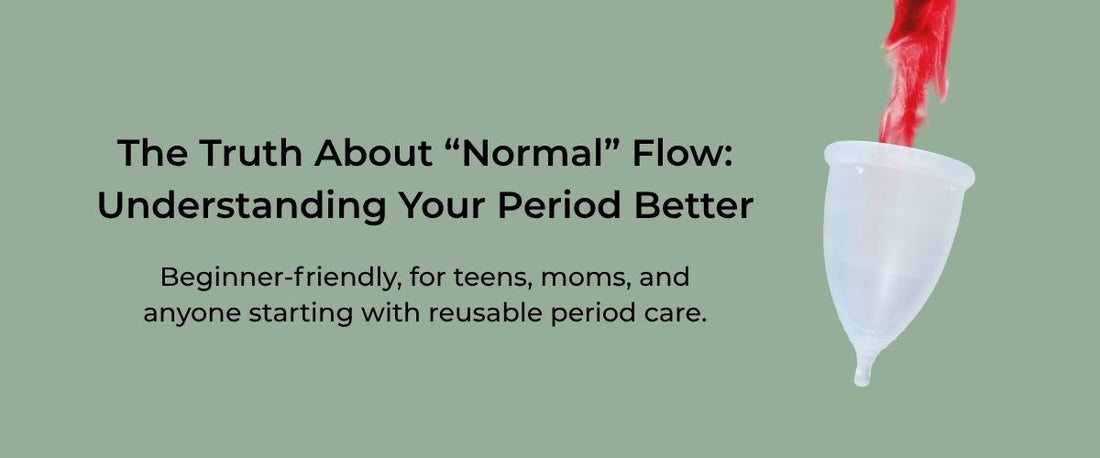
The Truth About “Normal” Flow: Understanding Your Period Better
Share
“What’s a normal period?”
Short answer: looks different on each body, but there are helpful ranges. This guide breaks down spotting, light, medium, and heavy flow, what’s worth nothing , and how a simple menstrual calendar can help you feel calm, confident, and in tune with your body.
What is Menstrual Flow?
Flow is how much menstrual blood leaves the uterus during your period. Must periods last 3-7 days with total blood discharged around 30 to 80 ml of blood (roughly 2 to 5 tablespoons). It can change month to month, and that’s perfectly okay. Patterns over time matter more than one random cycle.¹ ²
The Four Common Flow Levels
1) Spotting
- Very light smears or a few drops outside of your main period
- Often brown or light red.
- Common before a period starts or as it end.
- Pad/Liner change: every 4 hrs or as needed.
2) Light Flow
- Gentle, steady flow or bleeding.
- You may need an interlabial pad (ILP), light pad, or small cup/disc.
- Pad/Liner/ILP change: every 4-6 hrs or as comfort dictates.
3) Medium Flow
- ”Typical” for many people on days 1-2.
- Pads Change every 4-6 hrs; Cups/Discs can last up to 12 hrs (check device capacity and comfort).
- Some smalls cloths can be normal. ³ (always talk with your doctor for more information and about any concerns you may have)
4) Heavy Flow
- If you soak a pad in 2 hours or less, pass larger clots, or need to double up protection.
- If this happens often talk with your doctor. Heavy menstrual bleeding can be linked to treatable causes like thyroid, hormonal imbalances, fibroids, anemia. ⁴
Rule of Thumb: If it feels new, extreme, or worrying, it’s worth checking with a health profesional.
Period Color & Texture Quick Guide
- Bright Red: fresh flow, common on heavier days.
- Brown: older blood, common at start/end.
- Dark red with small clots: often normal on heavier days.
- Gray/green, strong odor, or unusual discharge: seek medical advice ⁵
Pain & Symptoms, what is “normal” discomfort?
Mild cramps, backache, or fatigue are common.
🚩Red flags: severe pain that disrupts life, dizziness, fainting, fever, or symptoms that suddenly change, book a visit to your doctor.
When to Seek Help (simple checklist)
- You soak through a pad/cup in < 2 hours repeatedly.
- Your Period last for more than 7 days often.
- Clots larger than a quarter coin regularly
- Sudden cycle changes or severe pain.
- You’re concerned. Your peace of mind matters.
How Tracking Your Cycle Builds Confidence
A menstrual calendar helps you spots patterns: start/end dates, flow level per day, symptoms, and leaks/stains to improve care. You will see what’s normal for you. Bring your notes to appointments, it speeds up good care.
- Download your Free Cycle Guide + Calendar
- Prefere Spanish? Calendario menstrual gratis
Choosing Protection That Fits Your Flow
💜Reusable Cups & Discs
Designed for Comfort. Made for Real life
Our reusable menstrual discs are made from 100% medical-grade silicone, Made without toxins, Made without Dyes, No latex and phthalates. Each pice is soft, flexible, and body-safe, providing up to 12 hours of leak-free protection, day or night.
💧Why they stand out:
- Long wear time: up to 12 hours of continuous comfort (even overnight).
- Eco-friendly: reusable for years, one cup or disc replaces hundreds of disposables.
- Budget-smart: long term savings with zero waste
- Body-safe: made without toxins, hypoallergenic, and FDA-compliant silicone.
- Freedom of movement: swim, sleep, or work comfortably without leaks.
Find your perfect fit and feel confident every cycle. See cups/discs
🩵 Reusable Pads by Hume's Period Care
Our Pads are made with:
- Organic Cotton Cores: Soft, breathable, sized for light to heavy; easy to wash. Made without toxins Explore cloth pad
- Eco-Friendly PUL barrier (Made in USA). Flexible waterproof protection that prevents leaks.
- Ag+ (silver-ion) antimicrobial infusion. Helps reduce odor-causing bacteria and keeps fabric fresher between washes.
💧Recommended wear times
- Pads without PUL : Change every 2-3 hours.
- Hume’s pads (with eco PUL + Ag ⁺ cotton): up to 4 hours of comfortable, leak-safe protection, or whenever you prefer a fresh change.
Focus on freshness, safety, and sustainability without sacrificing comfort. Explore Reusable Pads
💙Mix & Match
Many use a cup/disc during the day and cloth pads at night for breathable backup comfort.
Stains ≠ shame
Leaks happen. If you need stain tips or a pep talk, read Stains≠ Shame . You are doing grate.
Gentle Care & Washing Basics
Sterilize cups between cycles, just boil them in water for 5-7 minutes. Pads Rinse cold, wash with mild soap, air dry or wash them in a regular cycle ( don’t use gentle cycles, may not wash properly) warm water in your washer machine, and Dry them in the dryer. Simple routines = longer product life.
Wrap-up
Your “normal” is personal.
Use the levels above as guides, track a few cycles, and check in with a clinician when something feels off.
Confidence comes from knowing your pattern, and you’ve got this💙
💗 Ready to take control of your cycle?
→Get your Free Cycle Guide + Tracker and start learning how your body really works.
→Explore our Reusable Pads — soft, breathable, and made for real comfort.
→Coming soon: Compare Cup vs Disc vs Pad — which one fits you best? 💙
✨ Also read: Stains ≠ Shame — Confidence During Your Period
🧠 Quick FAQ
Q1. How much bleeding is too much?
Soaking through a pad or tampon every ≤ 2 hours for several hours qualifies as heavy menstrual bleeding. Contact your healthcare provider.⁴
Q2. Can stress change my flow?
Yes. Stress and sudden lifestyle changes can alter hormone balance and shift your cycle.⁷
Q3. Do reusable pads or cups change my flow?
No—they don’t affect how much you bleed, but they help you see and measure your real flow more clearly, especially when tracking.
🔗 Next in the Series
“Reusable Period Products: Why They’re Better — and How to Choose What Fits You.”
Learn why reusables are safer for your body, your wallet, and the planet. 💜 Coming soon.
📚 References (APA Style)
-
American College of Obstetricians and Gynecologists (ACOG). (2024). Menstrual Cycle: What’s Normal.https://www.acog.org/womens-health
-
Mayo Clinic. (2024). Menstrual Cycle: Normal and Abnormal Bleeding. https://www.mayoclinic.org
-
Centers for Disease Control and Prevention (CDC). (2024). Heavy Menstrual Bleeding (HMB).https://www.cdc.gov/blooddisorders/women/menorrhagia.html
-
National Institutes of Health (NIH). (2023). Abnormal Uterine Bleeding Fact Sheet. https://www.nichd.nih.gov
-
Cleveland Clinic. (2024). Vaginal Discharge and Infections. https://my.clevelandclinic.org
-
Johns Hopkins Medicine. (2024). Dysmenorrhea (Painful Periods). https://www.hopkinsmedicine.org
-
NIH Office on Women’s Health. (2023). Stress and the Menstrual Cycle. https://www.womenshealth.gov
